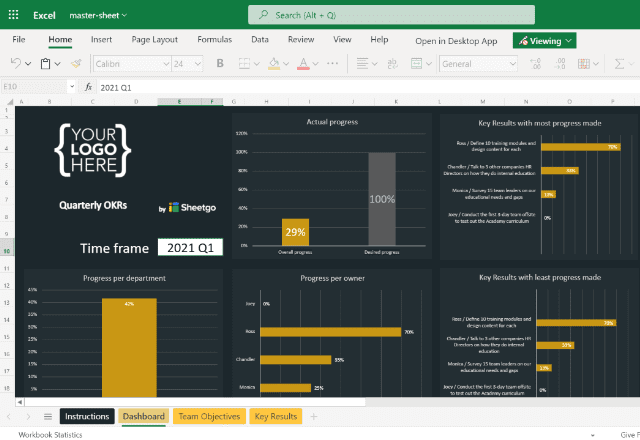Do you want to get started on the OKR system? The effortless way to begin is to ask yourself about the vision you have for your business. Usually, there is a motivation for starting a business; therefore, this is where your long-term priorities should be. Questions such as where you’d like to see your business in the next 5 years are great ways to begin, too, as they form your long-term objectives.
OKR Objectives and key results consist of an Objective– what you want to attain and Key Result – the milestones you’ll get to before reaching your objective.
Are you wondering where to begin when organizing your OKR template with some helpful information? Don’t worry- here are some 5 tips to help you navigate the process smoothly.
1) Keep Your OKR Template Simple
The key to making an effective spreadsheet is to focus on objectives you can comfortably achieve within the set timelines. You don’t want to be overambitious, as this will only make you less effective. Make your priorities depending on what actions are urgently needed in the business. Remember that you are not limited in the number of objectives you can have- it all boils down to time and available resources to implement the tasks.
2) Be Specific On Actions to Take
It is essential to have a picture of the road you’d like to take to achieve the set goals and objectives. You can make deliberations with your colleagues to come up with options available before writing it on the OKR template. When you are sure of the action to take, make an action plan that specifies how each and every action will be achieved. Be sure to be as clear and straightforward as possible.
3) Narrow Down Your Objectives
You don’t want a situation where there is vagueness in your objectiveness. Therefore, develop general objectives that trickle down to all employees. Each employee’s action in the template will ultimately contribute to the bigger goal, thus contributing to business success.
4) Make Your Key Results Measurable
Objectives and key results have two vital parts; the objectives and key results. Key results need to be measurable in whatever measures of quantifying. The goal here is avoiding instances where you’re not if you’ve set your objectives too high and, therefore, it’s impossible to reach.
5) Break Key Results into Smaller Goals
So, you have the key results you expect to achieve- fantastic! Sometimes getting to the main results means you have a series of mini-goals. Mini-goals are milestones through which you can measure whether or not you are on the path to top-achieving your main goal-this goes a long way in creating and encouragement to keep putting in the effort to achieve the main objective.
Are You Looking for A Simple Way to Set Your Goals?
Setting the appropriate goals for your business is a step towards growth. However, what’s key to achieving it is to further divide this general goal into sub-goals that can be channeled to all levels of the organization for individual contribution. Thankfully, the OKR template is here to help do this job!







